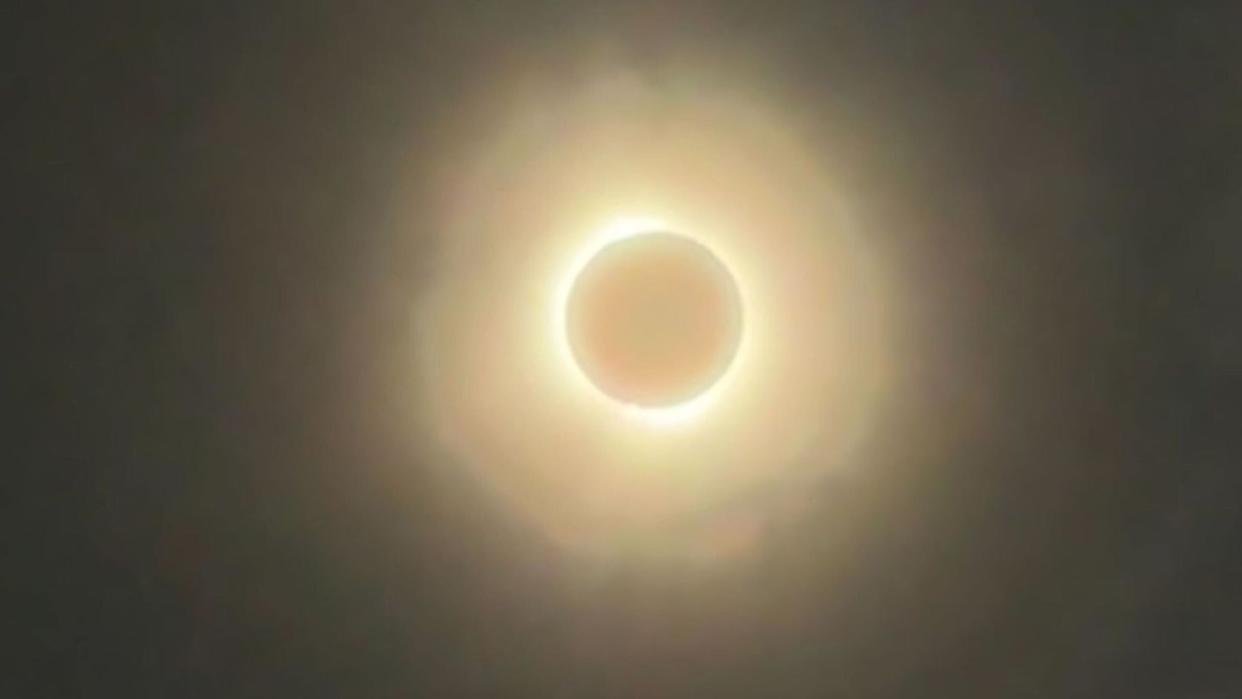This Is What It‘s Like To See A Total Solar Eclipse

Usually, I’m the only person in whatever group I’m in to get excited about space stuff (the rest of the team here at Popular Mechanics being a notable exception). It’s been a love of mine for my entire life, but to most people most of the time, it’s a mildly interesting passing thought.
Not today. Today, I got to watch a whole beach full of people care as much about space as I do. Because today, I traveled to Erie, Pennsylvania to see a once-in-a-lifetime event. I got to see a total solar eclipse.
Total solar eclipses are rare. One hasn’t hit this area since the 1970s, and the contiguous U.S. won’t experience another until 2044 (and even then, it’ll only graze Montana and North Dakota). So, it’s safe to say that it’s a big deal if you happen to be near the path of totality.
I was not, so I decided to travel out to Erie, and meet some friends and family in the area to all watch the eclipse together. Even being in the same country as a totality, it was impossible to resist going to see the spectacle.
But as hopeful and excited as I was, the day didn’t start off looking great.
I picked up my sister, and we left for our destination at about 7:00 a.m., trying to beat the traffic we knew would clog the highways closer to go-time. We successfully beat the traffic, but spent the entire drive being spit on by rain drizzling down from low, dark clouds. Not what you want to see when you’re awaiting a solar event.
Once we arrived, I opened up about six different weather prediction websites, and proceeded to panic, slowly and consistently, over the course of several hours. In this part of the country, low, heavy clouds don’t give up their grip on the sky easily. They are weapons of seasonal affective disorder, and are loathe to relinquish their power. For a long time, it wasn’t looking good.
And then 2:00 p.m. rolled around, and the whole sky cleared. Suddenly, it was the most beautiful day at the lake! We had a slight breeze, everyone applauded the sky—it was sunny and warm and, for a bit, perfect viewing weather. But I couldn’t help remembering the forecast I had been reading all day. 2:00 p.m. was supposed to be clear. At 3:00 pm, the clouds were supposed to return. And totality was scheduled for 3:16 pm.
I spent an hour intermittently watching the Sun through my eclipse glasses to marvel at the beauty of even a partial solar eclipse, and anxiously looking west to watch the clouds slowly but surely roll back in. I was tense, stressed, and pretty unable to calm down, despite all my loved ones trying to convince me it would work.
By 3:00 p.m., I was a wreck. The clouds were right up close to the Sun as it was whittled down to a sliver by the Moon, and the race was well and truly on. With just 16 minutes to go, every minute was stressful. I walked away from my group to pace on my own, begging the sky to please, just give me 16 minutes. And then 15. And then 10. And then 5. 4. 3. 2. 1.
Zero.
The lights on the whole world shut off. People cheered, and I’m not embarrassed to say I fully collapsed and cried—the shock of the sight and relief that I really did get to see it hitting me all at once. This was the realization of a dream I’ve had since childhood, and we made it. This was it. Totality. And it was everything I could imagine.
It. Was. Beautiful.
If you’ve never seen a total solar eclipse, I’m not going to be able to convince you of how stark the difference is between 99 percent obstruction and true, 100 percent totality. The light on the world changes, the birds start chirping, it gets cold, and there’s a ring in the sky that looks like something out of a fantasy novel. It can’t be real—it’s far too beautiful. It’s this ring of glowing white and blue in the sky for just a moment, and it changes the look of everything.
It's not just night come early. It’s the most convinced I’ve ever been of magic.
And we got extra lucky. Because this eclipse happened during a solar maximum, which means the Sun was extra active. Throughout all of totality, if you looked at the bottom of the ring, you’d see a little burst of orange—a full blown solar flare you could see with the naked eye.
I cried, I hugged my friends and family, and we spent a little less than 4 minutes watching one of the greatest natural phenomena a human being can experience. And everyone got it. For once, I wasn’t monologuing about why the thing we were witnessing was so cool, and why we should care. They got it. Because they could see it, too. We all could.
Less than four minutes later, the first flare of the Sun peaked back out from behind the Moon, in a flash referred to as the “diamond ring.” We all put our glasses back on, and watched the Sun re-emerge for a little while, marveling at the miracle we just saw.
Right now, we’re all watching the tail end of the eclipse in bits and pieces. It feels like it goes away a lot faster than it arrives, even though that makes no sense. Once the anticipation ends, time seems to move a lot more quickly.
Aaaaaaannnnddd… there it goes. The Sun is back, the Moon is gone, and everything is normal. If you looked at the sky at this moment, you wouldn’t think today was anything other than ordinary.
But we know. Because we were there. We saw it. And it was unbelievable.
You Might Also Like

